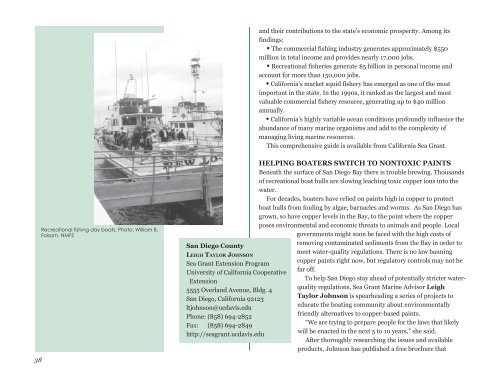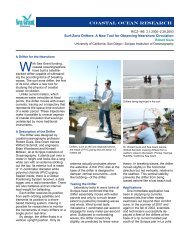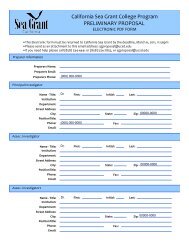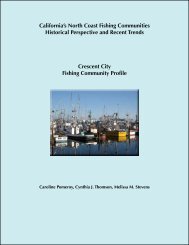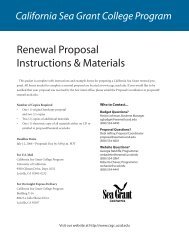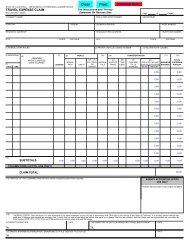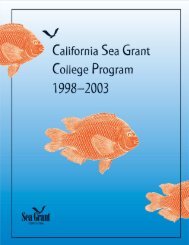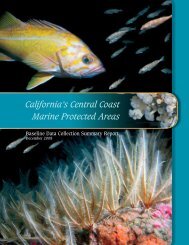2001â2002 - California Sea Grant - UC San Diego
2001â2002 - California Sea Grant - UC San Diego
2001â2002 - California Sea Grant - UC San Diego
You also want an ePaper? Increase the reach of your titles
YUMPU automatically turns print PDFs into web optimized ePapers that Google loves.
and their contributions to the state’s economic prosperity. Among its<br />
findings:<br />
• The commercial fishing industry generates approximately $550<br />
million in total income and provides nearly 17,000 jobs.<br />
• Recreational fisheries generate $5 billion in personal income and<br />
account for more than 150,000 jobs.<br />
• <strong>California</strong>’s market squid fishery has emerged as one of the most<br />
important in the state. In the 1990s, it ranked as the largest and most<br />
valuable commercial fishery resource, generating up to $40 million<br />
annually.<br />
• <strong>California</strong>’s highly variable ocean conditions profoundly influence the<br />
abundance of many marine organisms and add to the complexity of<br />
managing living marine resources.<br />
This comprehensive guide is available from <strong>California</strong> <strong>Sea</strong> <strong>Grant</strong>.<br />
Recreational fishing day boats. Photo: William B.<br />
Folsom, NMFS<br />
<strong>San</strong> <strong>Diego</strong> County<br />
LEIGH TAYLOR JOHNSON<br />
<strong>Sea</strong> <strong>Grant</strong> Extension Program<br />
University of <strong>California</strong> Cooperative<br />
Extension<br />
5555 Overland Avenue, Bldg. 4<br />
<strong>San</strong> <strong>Diego</strong>, <strong>California</strong> 92123<br />
ltjohnson@ucdavis.edu<br />
Phone: (858) 694-2852<br />
Fax: (858) 694-2849<br />
http://seagrant.ucdavis.edu<br />
HELPING BOATERS SWITCH TO NONTOXIC PAINTS<br />
Beneath the surface of <strong>San</strong> <strong>Diego</strong> Bay there is trouble brewing. Thousands<br />
of recreational boat hulls are slowing leaching toxic copper ions into the<br />
water.<br />
For decades, boaters have relied on paints high in copper to protect<br />
boat hulls from fouling by algae, barnacles and worms. As <strong>San</strong> <strong>Diego</strong> has<br />
grown, so have copper levels in the Bay, to the point where the copper<br />
poses environmental and economic threats to animals and people. Local<br />
governments might soon be faced with the high costs of<br />
removing contaminated sediments from the Bay in order to<br />
meet water-quality regulations. There is no law banning<br />
copper paints right now, but regulatory controls may not be<br />
far off.<br />
To help <strong>San</strong> <strong>Diego</strong> stay ahead of potentially stricter waterquality<br />
regulations, <strong>Sea</strong> <strong>Grant</strong> Marine Advisor Leigh<br />
Taylor Johnson is spearheading a series of projects to<br />
educate the boating community about environmentally<br />
friendly alternatives to copper-based paints.<br />
“We are trying to prepare people for the laws that likely<br />
will be enacted in the next 5 to 10 years,” she said.<br />
After thoroughly researching the issues and available<br />
products, Johnson has published a free brochure that<br />
38


